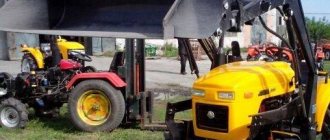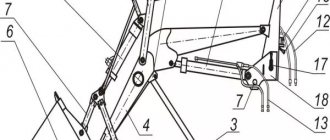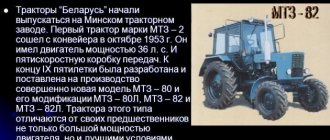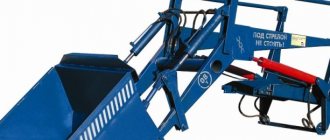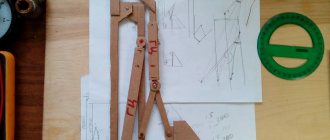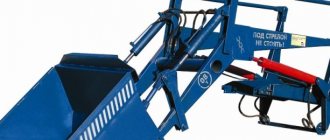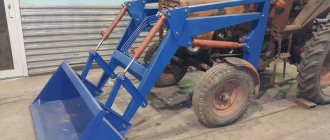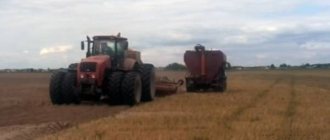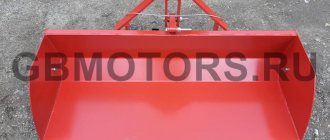Homemade kun (bucket) for a tractor - pros, cons of making
A tractor kun is a useful equipment for farming that allows you to level the top layer of soil, break up rubbish heaps and load trucks.
Of course, such multifunctional special equipment is quite expensive. In this regard, many enthusiastic farmers decide to assemble a loader themselves, especially since making a kun for a tractor is not as difficult as it seems. The most important advantage of a homemade kun is its low cost. Naturally, you will have to spend a little money during assembly, but at the final price, homemade tractor loaders will still be significantly inferior to their factory-made counterparts.
The second important advantage of the kun is that such an excavator can be used to work not only with domestic MTZ or Agromash tractors, but also with Kioti, Subaru tractors, as well as equipment from other imported brands.
The third advantage of a homemade kun is the simplicity of its design - this greatly simplifies its repair and maintenance.
The main disadvantages of creating a homemade loader include:
- a shortage of certain materials and equipment on the farm will lead to its purchase, which significantly increases the cost of a homemade kuna;
- Before assembly, you will need to practice a little in working with a grinder, a welding machine and a drill - this will allow you to more confidently hold the equipment in your hands directly when making a kun, as well as achieve better quality and balance when operating a tractor with a bucket.
In addition to the listed disadvantages, one more drawback should be highlighted in the form of a large amount of time spent on production. However, a properly made tractor bucket will quickly pay for itself due to its versatility and reliability.
Homemade loader for the rear linkage of an agricultural machine
This homemade bucket is considered the simplest option for use on T-25, T-40 tractors and other units whose design includes a rear linkage mechanism. This kun differs from a front loader in its ease of manufacture and installation on a tractor.
At the first stage of production, you will need to carefully study the drawings. They must indicate the size of each part used, as well as the method and sequence of its fixation in the overall structure.
After studying the diagrams, you will need to prepare the materials necessary for the work.
These include:
- metal profile and steel sheets - these will be used when assembling the base of the loader. The thickness of the metal used should be selected taking into account the size of the kun;
- swivel cylindrical joints – also selected based on the dimensions of the loader;
- 3 cylinders taken from the hydraulic system of any equipment unnecessary on the farm. Two of them must adjust the angle of the bucket. The third and largest cylinder is responsible for raising and lowering the boom.
From those used during work you will need:
- large hammer, mounting bolts, washers;
- screwdrivers, wrenches, pliers;
- powerful welding machine;
- gas cutter or grinder, capable of providing a perfectly even cut of metal parts.
The tractor loader is manufactured in the following order:
- First you need to assemble a base that is reliable and resistant to heavy weight. It should be taken into account that the frame will hold not only the bucket, but also the load it carries. The base of the kun should look like a rectangle assembled from square pipes. The lower part of the frame must be fixed to the tractor's hinged mechanism in such a way that it protrudes slightly beyond its edges. In the middle part of the frame you will need to install another rectangle welded from pipes. Next, you will need to install the largest cylinder on the inner rectangle. In its upper part you will need to first make 4 hinged joints to fix the boom, and a spacer;
- Next, the homemade loader must be equipped with a boom. It is assembled from a metal profile, the parts of which must be attached to each other at an angle of 30⁰. The hydraulic cylinder mount and the ends of the previously created base will need to be welded into the upper part of the boom;
- In the middle part of the boom you will need to install a hinge mechanism with a cylindrical shape. 2 movable joints are mounted into the mechanism, fixing 2 smaller cylinders together, as well as a crossbar used to install the bucket;
- The last step is to assemble the tractor bucket. To make it, you need to use one large steel sheet and 4 smaller parts. You will need to cut out rectangles from them, which, in the future, need to be welded to each other. In this case, the front sheet must be welded to the overall structure of the bucket at a certain angle. The video will tell you more about the manufacture of the loader.
During manufacturing, it must be remembered that a loader whose boom exceeds 2 meters in length will outweigh the tractor. To prevent this from happening, the front part of the agricultural implement will need to be weighted.
Manufacturing a front loader for a tractor
The front loader differs from the previous bucket in that it is mounted on a mounted mechanism located in the front of the tractor. In the future, such an excavator can be actively used for snow removal, leveling the site and clearing debris.
As in the first case, before manufacturing the loader you will need to study the drawings. They must be as accurate as possible so that the finished loader is extremely balanced and reliable.
Next, you need to collect all the materials and tools necessary for the work.
The work must be performed using the following raw materials and equipment:
- several sheets of steel - their sizes are selected depending on the dimensions of the loader;
- 2 large and 2 small hydraulic cylinders;
- bolts, nuts and hinge joints;
- grinders and drills;
- welding machine;
- pliers, screwdrivers, wrenches.
The sequence of manufacturing a front loader for a tractor should look like this:
- First of all, metal platforms must be installed under the front linkage mechanism of the tractor to serve as a support for the loader. In the installed platforms, you will need to make recesses for mounting rods;
- The next step is to assemble the arrow. To manufacture it, you will need to make 2 contours from profiles, which must be connected to each other at an angle of 30 degrees. Both circuits must be attached to each other by means of jumpers located in the lower, central and front parts of the structure;
- One vertical support must be welded to each circuit so that each of them protrudes in its upper part. One additional spacer must be welded to each support, the second side of which must be attached to the corner located in the central part of the existing boom;
- Eyelets need to be made in the back of the bucket welded from steel sheets. You will need to attach a boom to the bottom eye, and 2 small hydraulic cylinders to the top eye. The second ends of the hydraulic cylinders must be attached to the angle located in the central part of the boom. Large cylinders must be carried from the central part of the boom to a support installed in a vertical position;
- At the final stage, you will need to install the finished structure on the front linkage of the tractor.
In a self-assembled front loader, front hydraulic cylinders are responsible for its rotation, and large rear cylinders are responsible for bending and extending the boom.
Having studied the procedure for making the front and rear buckets, almost every farmer will be able to make a tractor with two buckets - such a unit will have the highest possible performance and will help in performing various agricultural and household tasks.
Men's thoughts | Topic author: Malaya
The question is somewhat out of season, but still. When mowing with a mower, the drive shaft touches the braces when lifting the attachment. I moved the fingers in the brackets to the middle position; when lifting, the shaft completely “shrank” and the mower frame was even slightly deformed. It’s good that it didn’t go into the box, otherwise I would have been completely upset. I put my fingers back in the upper position. So I’m thinking that maybe the tractor’s hitch bars are not original; the previous owner did a lot of weird things with it. The center distance in the beams is 800 mm.
V (Vito)
V (Vito)
Evgeniy (Maisie)
V (Vito)
V (Vito)
Kun, tractor bucket - types, DIY production, video
A tractor bucket is a type of loader for heavy equipment. According to the principle of operation, this is a standard front loader; a hydraulic system is responsible for its operation. KUHN turns equipment into an excavator, tractor loader, leveler or bulldozer.
The universal mounted bucket was originally made for the purpose of loading silage or hay. But the scope of application of this equipment has expanded significantly, which is why they are actively used in warehouses for transporting goods, in construction, for landscaping, and for snow removal.
Advantages of a tractor front loader:
- Convenient for maintenance, since all components are within reach and can be easily replaced;
- Quick installation and dismantling of various canopies;
- Reliable (this is not always the case with a homemade loader);
- High load capacity;
- The reinforced hydraulic system simplifies the operation of the unit.
Popular KUHN models
Depending on the load capacity and fastening system, there are two current KUN models:
- PF-1. Has its own supporting frame. Such a KUN for a tractor is mounted on the rear linkage. This minimizes the risk of the machine overturning when handling large loads;
- PKU-08. The equipment is compact and ergonomic and is mounted on a semi-frame. In this case, the balance of the tractor is disrupted and it can easily tip over.
Design Features
The KUN for equipment has the shape of an arrow, which is controlled by four hydraulic mechanisms - two help lift loads and two control the angle of inclination of the bucket. The drive is taken by the chassis, the system of which acts as a connector for attaching the bucket to the machine.
All loader controls are located in the operator's cabin and are not complicated.
You can choose other additional canopies to equip a tractor with KUHN:
- Buckets with a volume in the range of 0.35 - 1.5 m3;
- A fork device that performs work in agriculture and during loading;
- Log grabber. With its help, the equipment can be actively used for collecting firewood;
- Clamps for bales and rolls;
- Rake bars that help remove hay and hay;
- Jaw blade.
Basic parameters of a tractor with a bucket:
- The rake grid and other aggregated working parts have a load capacity of 500 and 800 kilograms;
- Loading height with a bucket and rake grid – 2.5 and 3.5 meters;
- The angle when unloading the bucket is 55 – 65 degrees.
The dimensions and performance of the bucket determine the chassis parameters. It is used to attach equipment to the tractor.
You can get acquainted with the specifics of how special equipment works with buckets in the video.
Homemade ladle
You can make a KUN for a mini tractor with your own hands, while saving money on the purchase of this device. You need to acquire a metal sheet (with a thickness of six millimeters), metal scissors, welding, iron pipes of various diameters.
The KUN for the tractor is made according to a simple scheme:
- The fasteners are welded to the box and motor. The structure is reinforced from below with a metal corner;
- The KUHN itself is manufactured. It is enough to cut a sheet of metal into rectangles, which are then welded into one structure. Welding must be of high quality so that the finished structure lasts longer. Pipes and rods with a diameter of 10 and 5 centimeters, respectively, are suitable for the racks;
- Installation of hydraulic booster. For its mobility, a sleeve with a diameter of about 3 centimeters is suitable;
- The support pipe is welded to the front of the unit, then the racks are combined and reinforced with “kerchiefs”;
- For normal rotation of the bucket, a cylinder installed on the right is used.
To make your own bucket, you need to know how to use welding and understand mechanics. If in doubt, it is better to purchase ready-made equipment that can be attached to the Kioti tractor and other popular models of equipment.
Operating rules
During the manufacture of a front loader, manufacturers pay due attention to the safety of the operator during operation.
When using small machines, you need to monitor the overload so that the small equipment does not tip over. This can be prevented by installing protective systems.
It is also worth following simple recommendations when operating a tractor with a bucket:
- When moving, the scoop must be in the down position;
- It is important to ensure that the KUN is lifted correctly during operation;
- Special equipment (including a tractor with two buckets) must be used strictly for its intended purpose.
When purchasing a mini tractor, you should make sure that important options and elements are available. So, if necessary, it is enough to purchase a tractor bucket and other canopies that can be attached to special equipment.
A tractor cart is mechanical equipment for transporting goods.
Structural and functional characteristics of the trailer A wood splitter is a specialized device that is used for splitting wood and logs, as well as for potato hillers for tractors - an indispensable type of equipment, the main purpose of which is For large landholdings and farms, the winter season is a true test. Frequent snowfalls Plowing the land with a tractor is one of the modern ways of intensifying agriculture, which has become possible. A hay mower for a tractor is an indispensable tool that helps to quickly get rid of weeds and bring Cultivators are among the main types of attachments. They are designed to loosen the top layer. A tractor-mounted sprayer simplifies the care of cultivated plants. Depending on the selected type
Among other advantages of a garden tractor, it is worth noting its multifunctionality and versatility - suitability for a wide range of jobs and areas of operation. These properties are guaranteed by tractor attachments - a set of additional implements and mechanisms that allow you to combine a whole range of autonomous devices in one unit.
Types of attachment adapters for tractors
The modern range of tractor auxiliary equipment is extremely diverse, which makes it possible to use it in several sectors of the national economy. Among them:
I. Agriculture:
- plows;
- tractor harrows;
- seeders;
- potato and garlic planters and diggers;
- multi-row seeders;
- fertilizer spreaders;
- mowers;
- sprayers;
- trailer;
- cultivators;
II. Construction:
- coon for a tractor;
- motor drill;
- trencher;
- rippers;
- winch;
- loader;
- cargo trailers;
III. Utilities:
- snow shovel;
- sprinkler;
- devices for washing concrete and asphalt;
- dispersers of sand and chemical reagents for melting ice;
- rotary snow blower;
- bulldozer bucket;
IV. Forestry industry:
- skidding attachment;
- loader.
You can buy them ready-made or make them yourself.
Methods for connecting attachments to a tractor
There are 3 mechanisms for aggregating the tractor with auxiliary attachments:
- hitch mechanism and hitch;
- towing devices;
- power take-off shaft (PTO).
The tractor hitch acts as a connector for lighter and smaller adapters. Modern tractors are produced with a three-point hitch. Although older models have a classic two-point hitch.
The hitch is used to aggregate the tractor with a trailed or towed device. Located in the area of the lower links of the hinged mechanism.
According to the method of connection, couplings are distinguished:
- universal;
- hydroficated;
- automatic.
Towing mechanisms are represented by hooks equipped with shock absorbers and locking blocks.
The PTO is a working unit that receives torque from the power plant and transmits it to the active attachment for tractors. Depending on the location, tractors come with rear and front PTO. Outdated units that were produced without a PTO can be improved with a homemade power take-off system.
How to make a KUHN ladle with your own hands?
- 1 Kun, tractor bucket - types, DIY production, video
- 2 How to make a kun, front loader, excavator bucket and shovel blade for a mini tractor with your own hands - TechnoExpert
- 3 How to make a kun ladle with your own hands - Metalist's Handbook
- 4 How to make a kun ladle with your own hands on MTZ video
A tractor bucket is a type of loader for heavy equipment. According to the principle of operation, this is a standard front loader; a hydraulic system is responsible for its operation. KUHN turns equipment into an excavator, tractor loader, leveler or bulldozer.
The universal mounted bucket was originally made for the purpose of loading silage or hay. But the scope of application of this equipment has expanded significantly, which is why they are actively used in warehouses for transporting goods, in construction, for landscaping, and for snow removal.
Advantages of a tractor front loader:
- Convenient for maintenance, since all components are within reach and can be easily replaced;
- Quick installation and dismantling of various canopies;
- Reliable (this is not always the case with a homemade loader);
- High load capacity;
- The reinforced hydraulic system simplifies the operation of the unit.
How to make a kun ladle with your own hands - Metalist's Handbook
A tractor bucket is a type of loader for heavy equipment. According to the principle of operation, this is a standard front loader; a hydraulic system is responsible for its operation. KUHN turns equipment into an excavator, tractor loader, leveler or bulldozer.
The universal mounted bucket was originally made for the purpose of loading silage or hay. But the scope of application of this equipment has expanded significantly, which is why they are actively used in warehouses for transporting goods, in construction, for landscaping, and for snow removal.
Advantages of a tractor front loader:
- Convenient for maintenance, since all components are within reach and can be easily replaced;
- Quick installation and dismantling of various canopies;
- Reliable (this is not always the case with a homemade loader);
- High load capacity;
- The reinforced hydraulic system simplifies the operation of the unit.
Kun, buckets, loaders and other attachments for mini tractors, drawings
The presence of a mini-tractor on a livestock farm or small agricultural enterprise today will not surprise anyone. Such equipment is needed every day to perform a range of agricultural and construction tasks.
From soil preparation and sowing to clearing the area of debris, snow, and remnants of building materials.
The use of various attachments allows you to further expand the functionality of compact agricultural machinery:
- bulldozer dumps;
- front loaders;
- excavator units and buckets;
- cultivators and harrows;
- tedder;
- sevalok.
The devices are controlled hydraulically and, due to their universal design, can be used with different models of mini-tractors.
Mounted universal hay hauler (kun)
Like other types of attachments, a mini tractor attachment is designed to increase the functionality of an agricultural machine. It significantly expands the farmer’s capabilities and makes it easier to perform various tasks. This arrow-shaped front linkage allows you to:
- load hay bales, silage, straw, rolls of roofing felt, building materials;
- perform earthmoving and road work;
- facilitate suburban construction and renovation.
Is it possible to make a bucket for a mini tractor with your own hands?
Even after purchasing agricultural equipment, some farmers try to modernize it, not wanting to spend money. Schemes for making some useful structural elements yourself come to the rescue. Thus, recently a bucket for a minitractor has become very popular, or rather, a bucket for an MTZ-82, designed with your own hands.
Mounted elements can be useful at any stage of agricultural work, be it sowing or clearing the area of dirt or snow. Tractor attachments are of the following types:
- dumps;
- loaders;
- buckets;
- cultivators, etc.
All these elements are controlled directly from the driver's cab. Hydraulic installations are used for this.
Due to the fact that the MTZ has a universal hydraulic design, any equipment can be mounted on it.
Next we will look at how to make a homemade bucket for a mini tractor with a rear linkage. A homemade bucket for a mini-tractor can perform a fairly wide range of tasks. The equipment is not very large in size, and is also multifunctional. It is recommended to use it both in small rural farms and on large farms or during the construction of any structures. Depending on the characteristics of a self-made mini tractor bucket, it can carry quite heavy loads and even dig up the ground to a depth of 3 m. All this allows the author of the homemade product to:
- Perform a number of basic earthworks.
- Create ditches or pits into which the foundation will be thrown.
- Transport various materials from one place to another.
- Load and transport harvested crops or fertilizers.
Do-it-yourself kun at MTZ: dimensions, drawings, photos, videos
The main differences between the MTZ-80 and MTZ-82 attachments. Main technical characteristics of KUNs for MTZ.
One of the most common and simplest types of special attachments, of course, can be called KUN at MTZ, which has become a kind of popular name - a common name for any similar type of attachments for tractors. KUN is a universal mounted hay hauler, which is essentially a tractor front-end hydraulic loader for moving, lifting and lowering various large loads.
However, if KUN is initially a hay hauler, this does not mean that it cannot work with other loads and materials that are not even remotely included in the category of hay and silage, and are not related to agricultural work.
The range of application of tractors with similar attachments is very wide and varied. For example, in the same excavation work, it is capable of moving large masses of soil from one place to another, covering any distance.
Advantages of front mounted equipment and technical capabilities
Slightly different equipment is installed on different modifications of Belarusian tractors, with minor technical and operational changes. Here the ratio of the load capacity and the canopy sweep may vary, which in one way or another directly affects the operation of the equipment and its tasks during operation.
1. MTZ - 80 with KUN is equipped with a prototype of the PF - 1 attachment, which has the following technical characteristics:
- weight of lifted loads up to 1 ton;
- lifting height limit up to 3.5 meters;
- the weight of the loader itself is 900 kg;
- maximum speed of cargo movement is up to 20 km/h.
2. MTZ-82 with KUN is equipped with a more advanced PKU-0.8 device than its prototype, which is somewhat narrower than its predecessor and lacks some parts, which include the so-called “rocker” with a quick-change mechanism.
- weight of lifted loads up to 800 kilograms;
- high-rise ceiling up to 3.5 meters;
- weight of the mounted loader up to 700 kg;
- maximum travel speed with load up to 20 km/h.
If the PKU - 0.8 is attached directly to the tractor frame, naturally disrupting the uniformity of the load during operation and putting pressure on the frame with the entire loaded mass, which leads to premature breakdowns when working with heavy loads, then the PF - 1 is equipped with its own frame, attached under the tractor to the rear axle , which evenly distributes the entire load.
In addition, PF-1 uses slightly more powerful cylinders, while the boom and other parts with mechanisms are made from reinforced (thickened) metal. Consequently, despite all the external similarities, the KUN on MTZ of different models still has significant differences in operation.
Note
Many skilled mechanics make the KUNS they need with their own hands, producing quite working and acceptable attachments. This does not mean that it is necessary and possible to refuse to purchase a high-quality factory product, but it does not exclude this possibility.
However, any homemade KUHN, even one manufactured according to all the rules and regulations, is certainly technically inferior to its factory-made counterparts.
How to make a KUN for a tractor with your own hands
A homemade KUN at MTZ is a special attachment that is designed to expand the functionality of the tractor. Installing a homemade or purchased KUN on the rear linkage of an MTZ tractor improves the operation of the machine.
What is the purpose of KUN at MTZ?
Such equipment is driven by a hydraulic system, which makes it possible to perform the following types of work:
- Build houses outside the city.
- Repair the road surface.
- Carry out various earthmoving works.
- Carry out loading and unloading operations.
The homemade product installed on a mini tractor with KUN can be of two types:
- Equipment type PF-1, which has its own supporting frame. This homemade KUN is attached to a tractor, which protects the machine from overturning. Such equipment weighs about 900 kg, is driven by hydraulic cylinders, has a load capacity of 1 ton and a speed of 20 km/h.
- The PKU-08, which is a more modern modification of the PF-1, is also installed on the rear linkage of the MTZ 82. It is not difficult to attach a homemade KUN or a KUN assembled by your own to a tractor. But it is worth considering that PKU-08 differs from MTZ in carrying less load than the previous arm of the equipment. The PKU-08 weighs only 700 kg, reaches a speed of up to 20 km/h, and is capable of lifting 800 kg of cargo at a time.
The kuna model on MTZ 80 or MTZ 82 is produced at the Salskselmash plant, which specializes in agricultural machinery.
KUN 10 is a functional and practical boom, created specifically for the specified MTZ models. Kun can also be installed on a Chinese tractor.
Although the equipment works better with Minsk technology. Among the advantages of KUN 10 it is worth noting such characteristics as:
- Versatility. The Belarus tractor is capable of being a loader and performing earth-moving work like an excavator. The machine is also used as a bulldozer or leveler.
- Compactness. The installation of KUN 10 at MTZ allows the equipment to be used in the city and on small construction sites. Therefore, such a tractor is constantly used for landscaping territories, digging holes and trenches, laying communications, etc.
- High level of productivity.
- Reliability.
- Ease of use.
- Easy to use.
KUN for wheeled tractors has the following design:
- The boom, which is controlled by four hydraulic mechanisms, two of them are used to lift loads, and another two are used to adjust the angle of inclination of the bucket.
- The drive that powers the chassis. Its system also has the option of a connector, with the help of which it is connected to the tractor.
- The boom control panel is installed in the tractor cab.
- Buckets can have different volumes, which vary from 0.35 to 1.5 m³.
Characteristics of a homemade unit
Homemade KUN for a mini tractor: installation features.
The manufacturer offers buckets of various sizes, fork equipment (needed for agriculture and loading and unloading), rake grids for collecting hay, straw, and mown grass.
Grabs for logs are sold separately, so KUNs are used for logging. Additionally there are grippers for bales and rolls. You can also find jaw dumps in stores. The basic equipment for a homemade KUN for a mini tractor may vary.
The dimensions of KUN 10 can be different, depending on the modification of the equipment. The carrying capacity of the rake grid, dumps and grabs is 500 and 800 kg.
The equipment bucket rises to a height of 2.5 m, and the rake grid - to 3.5 m. The unloading angle of the bucket, on average, ranges from 55 to 65º.
The performance and size of the equipment depend on the chassis that needs to be mounted on a homemade mini tractor or other self-propelled unit.
Buying attachments is expensive, so you can make a KUN for MTZ with your own hands.
Assembling and installing such a tool is simple, you just need to draw up a diagram of the equipment and mark on it the place where it will be mounted on the wheeled tractor.
A homemade KUN is attached to the rear linkage of an MTZ 80 or 82. This is much easier than installing a KUN 10, which is available in a front modification.
A homemade tractor differs from a factory one and has several significant advantages:
- Ease of mounting.
- Selection of the length and height that is necessary for specific work on the ground or at a construction site.
- You can use scrap materials left over from other equipment.
In order to make a KUN for a homemade or factory tractor, you need to stock up on the following equipment:
- welding machine;
- tools for cutting and cutting metal;
- sledgehammer;
- hammer;
- wrenches.
If you have no welding experience, then you should find a specialist who knows how to work with the machine. This determines the quality and reliability of welding seams, on which the installation and duration of use of the KUN largely depends.
Tractor magazine, issue thirteen: MTZ-2
Somehow I completely forgot about the tractor model releases, but since the last review, three new releases have already been released.
We need to catch up. In issue 13, a model of the MTZ-2 tractor, produced from 1954 to 1958, was presented. This small cabless machine with a 37 hp engine. and a maximum speed of 13 km/h was universal, but primarily intended for working with row crops (potatoes, beets, etc.). The model turned out to be very nice and well-designed, the steering turned out especially well.
Quite a few such tractors have survived to this day. One copy stands as a monument at the entrance of the Minsk Tractor Road, several pieces are in specialized museums, and some copies have been preserved by zealous owners, for example, this green tractor of one Estonian farmer. Interesting is the different arrangement of headlights on the model and the real car.
Photo: Silver Kuik, from the site techstory.ru The rear of the model also looks good, but the rear linkage turned out to be a bit rough. And it also seems that the size of the front wheels on the model is too big. But in general, the model turned out to be quite successful, I recommend it.
Traditionally, for comparison, here is a rear view of another surviving specimen, also from Estonia. And again the headlights are not the same as on the model. Interestingly, there was another option for the location of the headlight - at the tractor driver’s fingertips.
Photo: Mikhail Bednarsky For the 14th issue, the publishers chose the SHTZ-15/30 tractor, and its review will be coming soon.
Tags: Do-it-yourself bucket for the rear linkage of the T 40 tractor
